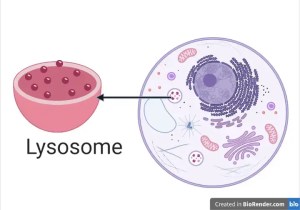
The word “lysosome” is derived from the Greek words; “lyso” meaning digestive, and “soma” meaning body. The lysosome is a membrane-bound cell organelle. It consists of the digestive enzyme, which digests the different intracellular and extracellular particles.
Lysosome consists of a variety of hydrolytic enzymes which are active in acidic conditions. These enzymes break down the complex molecules into smaller particles. Large proteins break down into amino acids, carbohydrates into simple sugars, and lipids into fatty acids. These simplest particles act as nutrient to the cell. If these complex molecules can’t be broken down into a simpler form, then it is called lysosomal storage disease. Example: Hurler syndrome. In this condition, there is a defect in the metabolism of the mucopolysaccharides.
Lysosomes destructs the different damaged cells by the apoptosis process. Similarly, lysosomes destroy foreign particles like bacteria and prevent infection.

Table of Contents
Lysosome is round, vacuolar, and filled with dense material. It varies in shape and density. Its size ranges from 0.2 to 0.5 μm. There is variation in the shape and size from one cell to another and from time to time.
It is spherical and has the lipid bilayer, i.e., phospholipids. It consists of a hydrophilic phosphate group head, glycerol molecule, and hydrophobic fatty acid tails. Lysosomes formation occurs by budding off from the Golgi apparatus. Hydrolytic enzymes are present in the lysosome. These enzymes are formed in the endoplasmic reticulum. Then the formed enzymes are tagged with mannose-6-phosphate. It is then transported in vesicles to the Golgi apparatus and packed into the lysosomes.
Lysosomal membrane can fuse with the other membranes of the cell, which is its main characteristic. The lysosomal membrane protects from the action of the lysosomal proteases. Once the lysosomal membrane ruptures, it releases the lysosomal enzymes. Lysosomal enzymes need an acidic medium for their action. So to maintain the acidic environment, there is the accumulation of the H+ inside the organelle. Finally, when the macromolecules digest, the final products get transported. They are either excreted or utilized by the cell.
Lysosomes are of four types: primary lysosomes, heterophagosomes, autophagosomes, and residual bodies.
Primary lysosomes
A single membrane binds the primary lysosomes. A primary lysosome is also known as the storage granules, protolysosomes, and virgin lysosomes.
Heterophagosomes
They are also called heterophagic vacuoles, heterolysosomes, and phagolysosomes. Heterophagosome is formed when the primary lysosome fuse with the cytoplasmic vacuoles.
Autophagosomes
The other terms used for autophagosomes are autophagic vacuoles, cytolysosomes, as well as autolysosomes. Autophagy is the process of autodigestion. Autophagy can occur in different forms. It can occur by the fusion of the lysosomes or by the formation of a vesicle and fusion with the primary lysosome.
Residual bodies
Residual bodies are also called telolysosome and dense bodies. In the absence of the lysosomal enzymes, incomplete digestion takes place that results in the formation of the residual bodies. The undigested food particles remain as the residue inside the digested vacuoles. The residual body is large in size and irregular in shape.
Lysosomes digest the extracellular and intracellular particles. The phagosomes or pinosomes present the extracellular substances. The lysosome digests intracellular substances like the stored glycogen, lipids, as well as proteins.
Lysosome prevents the infection by destroying the foreign bacteria inside of the cell.
In the sperms cell, the lysosome digest the membrane of the ovum facilitating the penetration of sperm through it.
References
Verma, P. S., & Agrawal, V. K. (2006). Cell Biology, Genetics, Molecular Biology, Evolution & Ecology (1 ed.). S.Chand and Company Ltd.